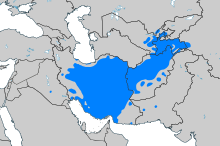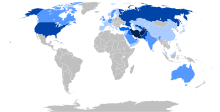Pho-su-gí
(Tùi Persian language choán--lâi)
Pho-su-gí (فارسی ; Lô-má-jī: fārsi; phosu-gú) sī Indo-Iran gí-giân ê chit-ê hun-chi, Iran ê chú-iàu gí-giân, tī A-hù-hān téng hū-kīn kok-ka mā ū chin choē sú-ēng-chiá.
| Phosu-gú | |
|---|---|
| فارسی (fārsi), форсӣ (forsī) | |
 Fārsi written in Persian calligraphy (Nastaʿlīq) | |
| Hoat-im | [fɒːɾˈsiː] (thiaⁿ ) |
| Goân-chū kok-ka |
|
| bú-gí sú-iōng-chiá |
70 million[8] (110 million total speakers)[7] |
| Gí-hē | |
| Chá-kî hêng-sek |
Old Persian
|
| Piau-chún-im | |
| Hong-giân | |
| Bûn-jī hē-thóng |
|
| Koaⁿ-hong tē-ūi | |
| Koaⁿ-hong gí-giân |
|
| Koán-lí ki-kò͘ |
|
| Gí-giân tāi-bé | |
| ISO 639-1 |
fa |
| ISO 639-2 |
per (B) fas (T) |
| ISO 639-3 |
fas – pau-hâm tāi-béPau-hâm tāi-bé: pes – Iranian Persianprs – Daritgk – Tajik languageaiq – Aimaq dialectbhh – Bukhori dialecthaz – Hazaragi dialectjpr – Judeo-Persianphv – Pahlavanideh – Dehwarijdt – Judeo-Tatttt – Caucasian Tat |
| Glottolog |
fars1254 |
| Linguasphere |
|
 Areas with significant numbers of people whose first language is Persian (including dialects) | |
 Persian linguasphere Legend Official language
More than 1,000,000 speakers
Between 500,000 and 1,000,000 speakers
Between 100,000 and 500,000 speakers
Between 25,000 and 100,000 speakers
Fewer than 25,000 speakers to none | |
Tsù-kái
siu-kái- ↑ 1.0 1.1 1.2 Samadi, Habibeh; Nick Perkins (2012). Martin Ball; David Crystal; Paul Fletcher, pian. Assessing Grammar: The Languages of Lars. Multilingual Matters. p. 169. ISBN 978-1-84769-637-3.
- ↑ Foltz, Richard (1996). "The Tajiks of Uzbekistan". Central Asian Survey. 15 (2): 213–216. doi:10.1080/02634939608400946.
- ↑ "IRAQ". Encyclopædia Iranica. 7 November 2014 khòaⁿ--ê.
- ↑ Akiner, Shirin (1986). Islamic Peoples of the Soviet Union. London: Routledge. p. 362. ISBN 0-7103-0188-X.
- ↑ Pilkington, Hilary; Yemelianova, Galina (2004). Islam in Post-Soviet Russia. Taylor & Francis. p. 27. ISBN 978-0-203-21769-6.
Among other indigenous peoples of Iranian origin were the Tats, the Talishes and the Kurds.
- ↑ Mastyugina, Tatiana; Perepelkin, Lev (1996). An Ethnic History of Russia: Pre-revolutionary Times to the Present. Greenwood Publishing Group. p. 80. ISBN 978-0-313-29315-3.
The Iranian Peoples (Ossetians, Tajiks, Tats, Mountain Judaists)
- ↑ 7.0 7.1 7.2 7.3 7.4 Windfuhr, Gernot: The Iranian Languages, Routledge 2009, p. 418.
- ↑ "Persian | Department of Asian Studies" (ēng Eng-gí). 2 January 2019 khòaⁿ--ê.
There are numerous reasons to study Persian: for one thing, Persian is an important language of the Middle East and Central Asia, spoken by approximately 70 million native speakers and roughly 110 million people worldwide.
- ↑ Constitution of the Islamic Republic of Iran: Chapter II, Article 15: "The official language and script of Iran, the lingua franca of its people, is Persian. Official documents, correspondence, and texts, as well as text-books, must be in this language and script. However, the use of regional and tribal languages in the press and mass media, as well as for teaching of their literature in schools, is allowed in addition to Persian."
- ↑ Constitution of the Republic of Dagestan: Chapter I, Article 11: "The state languages of the Republic of Dagestan are Russian and the languages of the peoples of Dagestan."
| Pún bûn-chiuⁿ sī chi̍t phiⁿ phí-á-kiáⁿ. Lí thang tàu khok-chhiong lâi pang-chō͘ Wikipedia. |